
MARS ROVER MISCELLANEOUS
EVIDENCE
Report #135
February 22, 2008
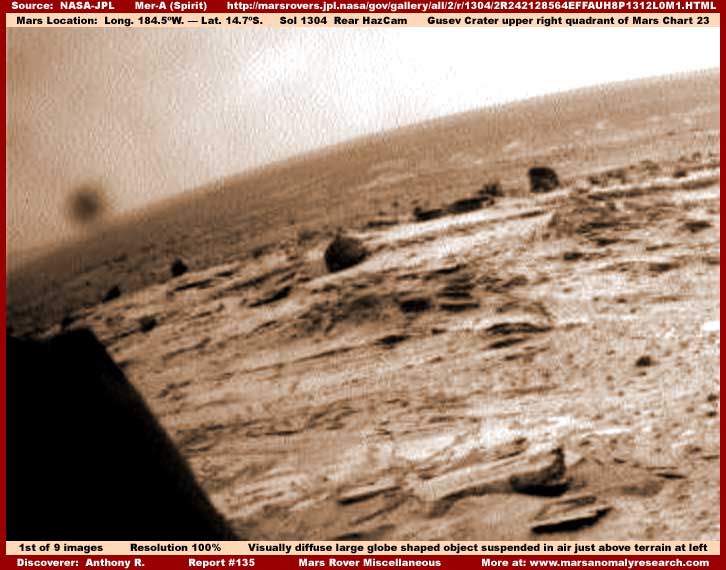
http://marsrovers.jpl.nasa.gov/gallery/all/2/r/1304/2R242128564EFFAUH8P1312L0M1.HTML
As you can instantly see in the above
first image taken on Sol-1304 by the rear hazcam wide-angle camera on the
Spirit Rover, there is a large anomalous object suspended in the air just
above the terrain not too distant from the rover's position and in the upper
left of the image. Note that the shape is clearly globular, that the object
is solid enough that it appears to obstruct sunlight but without reflecting
it and at the same time is strangely visually diffuse. This object in this
image was brought to my attention by Anthony R. of New Haven, CT inquiring
as to my opinion of what it might be.
Now before you get going on this suspect object, let me say ahead of time
that this is not anything real on Mars. It is almost certainly an artifact,
smudge or flaw on the camera lens but that isn't the whole story. It only
started showing itself visually starting a few Mars Sol days before this image
was taken on Sol-1304. Very much before that time it was not present and after
that time it is always present when the same left rear hascam lens is used
while never appearing when the other right hazcam lens is used in side-by-side
companion shots.
I'm including this evidence here because it is so visually pronounced drawing
attention and others may mistake it for something real on Mars. So, if it
isn't real, then the question becomes why did this artifact suddenly visually
start showing up where it did not do so before? That question is likely answered
by the evidence in the next image below.
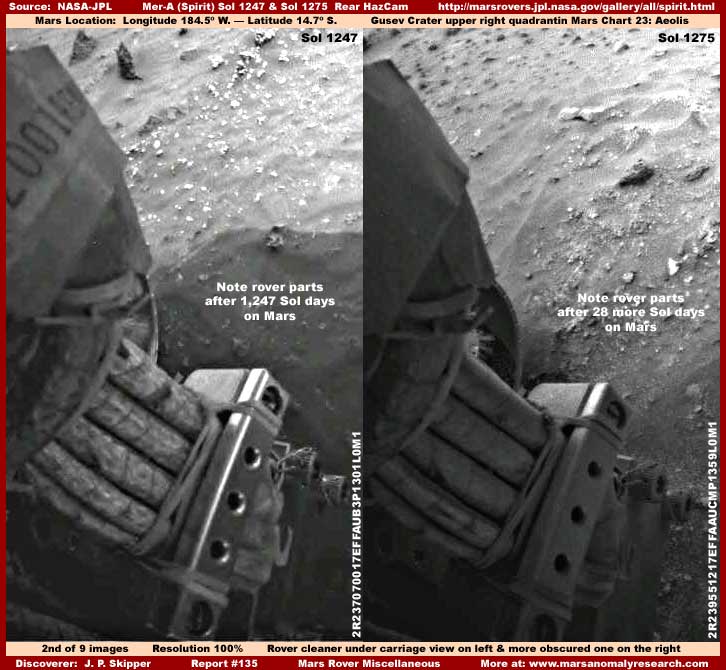
http://marsrovers.jpl.nasa.gov/gallery/all/2/r/1247/2R237070017EFFAUB3P1301L0M1.HTML
... (left
panel)
http://marsrovers.jpl.nasa.gov/gallery/all/2/r/1275/2R239551217EFFAUCMP1359L0M1.HTML
... (right panel)
What you're looking at in the above
second split frame image is some of the rover support structures on the underside
of the rover below the solar panel deck where the rear hazcam wide-angle camera
system is located. In the left image frame you see rover rear underside structures
as seen by the camera left lens system on Sol 1247
that are relatively clean with some shinny metal surfaces clearly showing
and note that these structures are in this relatively clean state after 1,247
Sol days exposure on Mars. This is an example of the support structures taken
in a time just before the first image camera lens artifact further above started
being seen.
The split image on the right however demonstrates the same underside structures
just 28 days later on Sol
1275 as seen by the same left hazcam imaging system. As you can see,
the underside rover structures in the right frame appear to be covered with
a very uniform coating of what at first glance might be assumed to be dust
or soil. However, I'm going to suggest that this isn't dirt, dust or soil
on this rover undercarriage or anything real for that matter. Rather, in my
opinion, it is covering of dithering smudge applications applied universally
and wholesale to everything solid apparently in conjunction with the use of
this left lens filter. Aren't technological advancements just wonderful?
Note the part of the rover in the upper left of each image and note the writing
clearly visible on this broader surfaced rover part, Now note the absence
of the writing in the right frame as it has been covered over by the applications
of smudge. Note that the applications are thicker there on this part than
other visible rover parts below it. That is likely in part because the surface
is broader surfaced and larger and broader is no doubt in this case mistakenly
interpreted by the automated tampering software as possibly closer and closer
suggest better views and we can't have that now can we. Likewise, the writing
on this part itself sends up red flags for the software and so this part also
gets some extra thick treatment for that reason as well than the rover structures
further down do not get.
The only problem with all this is that these increased degree of applications
are also visually applied to what is likely and normally a harmless artifact
or distortion flaw on the camera lens that normally would have been invisible
to us but which increased applications collecting to it now bring this lens
flaw into visibililty. This clue tips us off to the presence of this slight
of hand as someone or something increased the degree amount of smudge being
applied just a little too much now showing up as the lens artifact. All this
coincides timing wise with the increased but subtle degree of smudge applied
to the lower rover parts that would not normally be noticeable to us except
for the A-B side-by-side imaging demonstrating this revealing change.
This universal coating is wholesale applied and subtly covering the darker
color object out there in the field that the camera is taking an image of.
The rover under carriage was just incidentally effected and not the target.
Rather, in the open terrain, this effectively obscures specific objects and
also degrades resolution inhibiting the ability to zoom in on objects for
better definition. This prevents closer examination of the larger darker solid
objects unless they are large enough to over power it and then require more
object specific treatments.
Now another significant part of the reason that the anomalous first image
object is so fuzzy and strange appearing is due to the highly .jpeg compressed
very poor quality of this science data as it has been processed and released
for public consumption. This poor quality processing and presentation completely
circumvents the fact that this rover digital imaging was suppose to be some
of the best super high resolution imaging ever that we tax payers paid for.
In my opinion, this very high .jpeg compression too is a wholesale intentional
part of the general obfuscation process as it too prevents sufficient closer
examination of evidence.
Of course one could also just conclude (rationalize) that the rover underside
just pick up this highly uniform coating of Martian
dirt on the carriage components. Perhaps due to an increased static electricity
load picked up by the rover over just 28 days after 1,247 days of not having
it? The choice is yours. Okay now let's move on from this unpleasant stuff
to anomalous evidence with increasingly more interest potential.
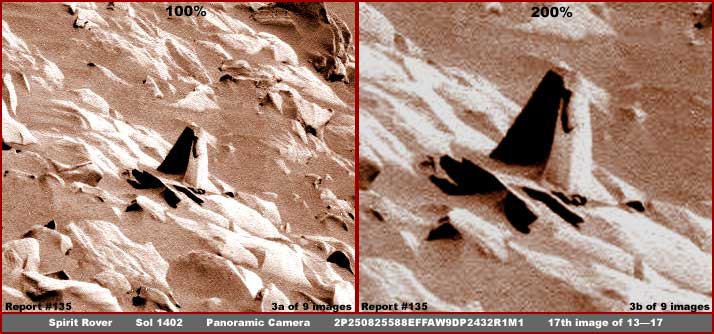
http://marsrovers.jpl.nasa.gov/gallery/all/2/p/1402/2P250825588EFFAW9DP2432R1M1.HTML
The above third split frame image demonstrates
an object in the terrain out from the Spirit rover brought to my attention
by amateur astronomer Kevin J. Brant wondering what I thought it might be.
Now I can't say definitively what this is, whether a rock or something artificial,
but I can say what it looks a little like and is suggestive of.
Note that the left frame is a official size scale view at 100% and then a
closer zoom view at 200% on the right. I have added color to give the scene
a more comfortable look. As you can see, if it is a rock, it is very unusual
looking to be that. Not impossible, just improbable. In basic shape it actually
looks very suggestive of a Metronome used on Earth in timing a musical beat
as seen in the below fourth image. Note that this Mars object appears to be
a hollow shell adding a bit of emphasis to the artificial Metronome instrument
interpretation as a possibility.
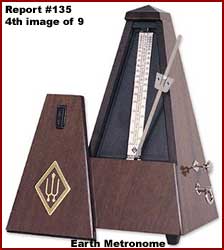
However, if it is something like an old Metronome instrument as seen in the above fourth image, the one on Mars is clearly now nothing more than a severely weathered abandoned and deteriorated housing exposed to the elements. Back up at the third image, note that any lower front panel cover is missing as are the inner components and it is now only a basic hollowed out shell with soil spilling out of its interior. Further, note that it appears to possibly be sitting on a wider platform base equally deteriorated and a bit broken up but likely the only reason it is still sitting in such an upright position. The dark object on its upper portions might be a badly deteriorated shriveled piece of attached metal. In any case, there is the visual evidence and you must decide its interpretation for yourself.
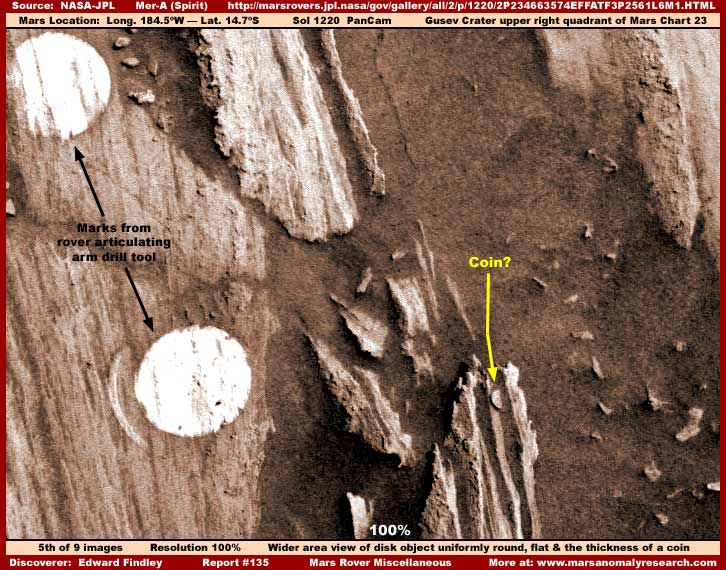

http://marsrovers.jpl.nasa.gov/gallery/all/2/p/1220/2P234663574EFFATF3P2561L6M1.HTML
The above fifth and sixth images demonstrate
a small round flat disk on the ground pointed out with the yellow arrow apparently
caught in a rock crevasse that is also filled with what looks like soil. If
it is soil and not dithering smudge image tampering, the soil covers roughly
half the disk hiding that portion from view. Note that the surface of the
disk reflects sunlight a little more than the adjacent rock surfaces and more
uniformly. This suggests that this object may very well be smoothed metal.
Also note the uniform thickness of the disk as demonstrated by its left exposed
portion casting a short shadow against the rock surface it is laying on.
Now this disk obviously looks like a metal coin and is very suggestive of
that as many of us will see it. However, without the fine detail of the disk's
surface, we can't be conclusive beyond this being just very suggestive. This
inconclusive situation to a large extent is a function of the very high .jpeg
compression on this imaging as released for public consumption. This object
is plenty close enough to the Spirit rover panoramic camera that such details
should be available to us if this imaging is as good as it was suppose to
be.
In the past, the NASA/JPL hype prepared the public for the near future rover
imaging to come. There was much bragging about the super high digital definition
setting a record at that time for the massive pixel count that could be expected
of the rover imaging. I have no doubt that this bragging entirely represented
the truth but look what is released to us with all that mega definition stripped
away by severe .jpeg compression processing and now posing as the real raw
science data, but isn't.
At this close range to the rover panoramic camera, we should be able to zoom
in on this object and determine its surface details, which of course would
at the very least give us a fine idea as to whether this is a actually a coin
or not. If this was some of our own personal fairly crude photography here
on Earth using just 3-5 megapixel cameras and using just a high quality .jpeg
compressed format, we would be able to do so. But here, with state of the
art scientific cameras and with super high resolution many many times what
our personal digital cameras can produce and paid for my taxpayers, we're
lucky to be able to determine that this is a disk at all. Further, I suspect
that even this crude visual awareness of ours is not welcome in certain quarters.
It's easy to get mad about this. It is also especially frustrating for someone
like me trying to determine the value of evidence and bring it to your attention.
On the other hand, I am reminded of an entire world full of skilled academics,
scientists, engineers, graphics specialists, and those interested in photography
being so blind to the obvious. How can so many of these millions of people
looking at their own photography and even some looking in Earth satellite
imaging, not see this super obvious right in one's face visual disparity?
It is clearly impossible and yet no one questions it or feels compelled to
question it.
People treat us like this because we allow them to do so. By allowing it,
we enable this treatment's conceptualization in the heads of others and so
they follow through serving their own interests and agendas at our expense.
It's a clue! By going along with it, refusing to question it, not demanding
more for ourselves, and thinking we don't want to be disturbed by issues we
find hard to grasp, we literally become the problem. When we accept someone
peeing down our collar and their trying to convince us it is raining, we deserve
what we get. Pathetic! Ooops! My frustration is showing, so I'll move on.
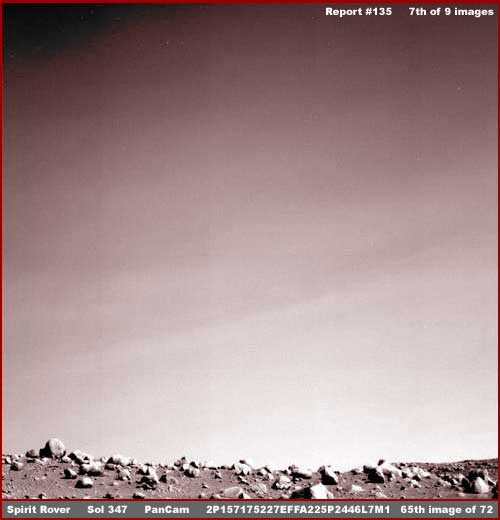
http://marsrovers.jpl.nasa.gov/gallery/all/2/p/347/2P157175227EFFA225P2446L7M1.HTML
The above seventh image is very simple and straight forward. It demonstrates hazy light reflective high elevation cloud conditions in the Mars atmosphere. Note the edge of the clouds in the image upper left corner demonstrating a gap in the sunlight reflective cloud cover and then the darkness of space beyond. I'm not going to waste image space on it here but I could have produced several images at various dark, light and contrast levels that would have made the cloud patterns more obvious. However, there is no image room for that here and the point is that what you are looking at is water vapor and moisture presence in the Mars atmosphere. That fact sets up the conditions for the next image evidence below.
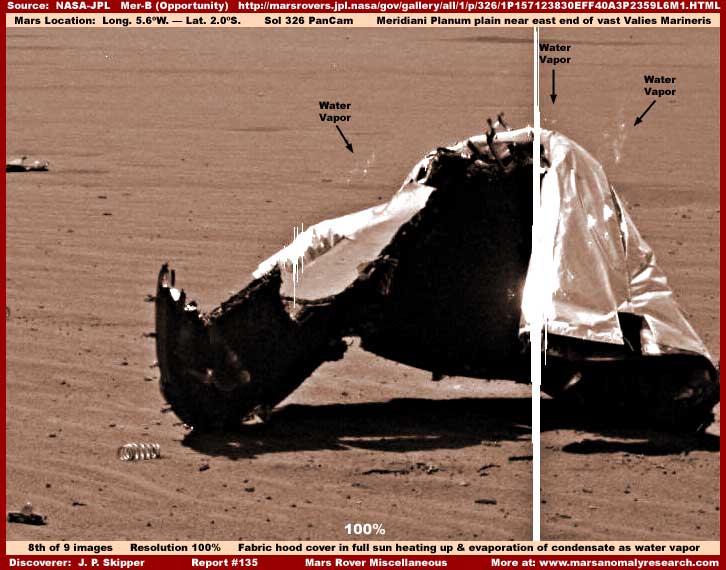
http://marsrovers.jpl.nasa.gov/gallery/all/1/p/326/1P157123830EFF40A3P2359L6M1.HTML
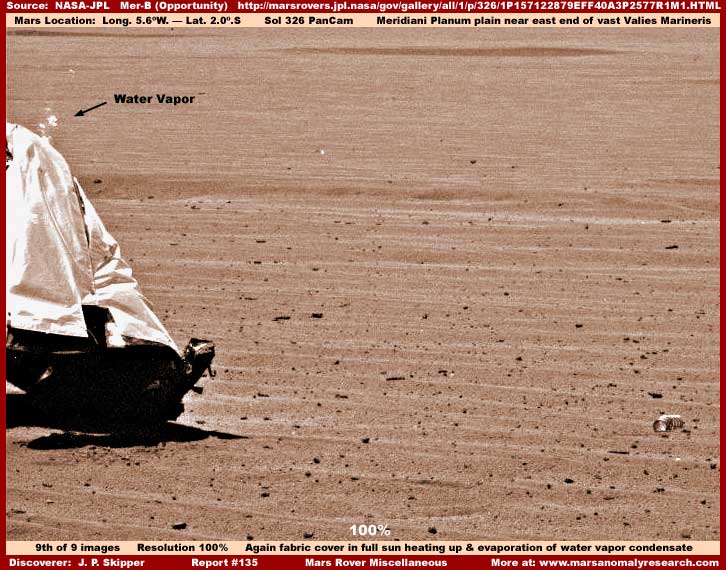
http://marsrovers.jpl.nasa.gov/gallery/all/1/p/326/1P157122879EFF40A3P2577R1M1.HTML
The above eighth and ninth images taken
by the Opportunity rover demonstrates an equipment visitor from Earth onto
the surface of Mars. Now your eye is suppose to concentrate only on the dramatically
obvious Earth equipment and that was the point in the rover taking these shots.
However, there is more to be seen here in the small accompanying details and
no the springs laying on the ground aren't what I'm referring to.
Note carefully in each image the puffs of moisture vapor drifting upwards
pointed out by my arrows. Now note carefully in each image the type of straight
down shadows being cast on the ground by this equipment demonstrating the
fact that the sun is directly overhead and it is the middle and hotter part
of the day on this Sol day 326
on Mars when these shots were taken.
Be reminded that this shell from Earth has been sitting in this spot for 326
Mars days heating and cooling with each Mars day and night cycle. That's a
lot of daily cycles and a long time. In fact, it is simply too long for something
within this shell to be still smoldering and generating smoke from a heat
source. There are a number of images of this vapor puffs drifting upward evidence
but I've chosen only the above two to present here.
With such a thin atmosphere on Mars and in such a bare arid spot, you can
image that it must get quite cold during the night and this equipment of course
as a mostly solid object eventually gets quite cold along with it and that
this cooling process happens very rapidly during the earlier cooling down
evening hours. So, as evening comes on, there will at first be a temperature
differential between the warmer than the environment solid object equipment
as the temperature rapidly goes down and any moisture in the air could be
expected to condense onto the warmer for a while equipment surfaces. Likewise,
Then comes morning and the sun beginning to heat things up to some extent
and the equipment by morning will be cooler for a while than the warming environment
meaning that any moisture in the air via temperature differential would again
condense out onto the cooler equipment surfaces.
You'll note that this equipment object is hollow and open in many of its areas
and it is hooded by a fabric cover. Any atmospheric moisture (remember those
clouds in image #7) would be able to access the inner areas of this equipment
including under the hood fabric. By the middle hotter part of the Mars day
and the equipment warming up as a solid object, any moisture on the upper
sunlight striking surfaces would likely be evaporated away but down below
the covering hood condensate moisture would likely be collected there and
still evaporating. It would be rising and finding its way out of gaps in the
hood cover just as you see in the above images.
Yes it was a mistake to not cover up this evidence and a human might well
have caught this evidence and done away with it because it is fairly obvious
once attention is focused on it. However, the obfuscation process is necessarily
performed by automated software operating on super fast computers simply because
there are too many incoming images to do otherwise and is only as good as
what its programming is designed to anticipate. It is very good but there
are just far too many variables in an entire world's environment to anticipate
and program in every single thing. So it is understandable that small puffs
of vapor would not logically be anticipated or a part of the software's programming.
The bottom line is that, if atmospheric moisture can condense out and adhere
to this solid object equipment's components, it can do the same thing in many
select areas favorable to it in the Mars surface geology. You then have the
undeniable basis for a cycle of life based on this moisture factor alone taking
advantage of the condensate moisture presence. That's what you're looking
at in those little puffs of rising vapor and those clouds in the Mars sky.
It's hard evidence and it's a clue!! Do you still think life is not possible
on Mars? Likewise, perhaps you can now understand better why general wholesale
obfuscation occurs in this imaging as evidenced in my first and second images
in this report and why obfuscation isn't just limited to specific evidence.
For example, the presence of a condensate moisture cycle could produce a life
cycle for smaller size life attached to certain rocks in the terrain such
as with the lichen on rocks that I've previously reported on in my Report
#109 and Report
#98. Rocks or rocky areas with lichen clearly growing on it plainly seen
would not do at all and the wholesale obfuscation works well on this type
of smaller scale evidence blurring it out and preventing a closer look. You
might be suspicious of the rocks rougher surface outline and many rough small
projections not characteristic of rock geology but the details are sufficiently
obscured preventing one from being sure.
, Investigator
![]()